Salomon v Salomon Case Study: The Principle of Corporate Veil
VerifiedAdded on 2023/05/27
|6
|1409
|200
Case Study
AI Summary
This case study provides an in-depth analysis of the landmark case Salomon v Salomon, focusing on the principle of the corporate veil and its implications for company law. The case revolves around Mr. Salomon's incorporation of his business and the subsequent legal challenges regarding the liability for the company's debts. The court's decision established that a company is a separate legal entity, distinct from its owners, thereby protecting shareholders from personal liability for the company's debts. The paper further discusses the potential future developments in corporate law, suggesting possible changes to address the misuse of the corporate veil for fraudulent activities, advocating for holding individual shareholders accountable for actions that lead to financial instability, and emphasizing the need to balance the protection of individual property rights with the interests of creditors. The case study concludes by referencing several scholarly articles that provide further insights into the corporate veil principle and its application in modern corporate law.
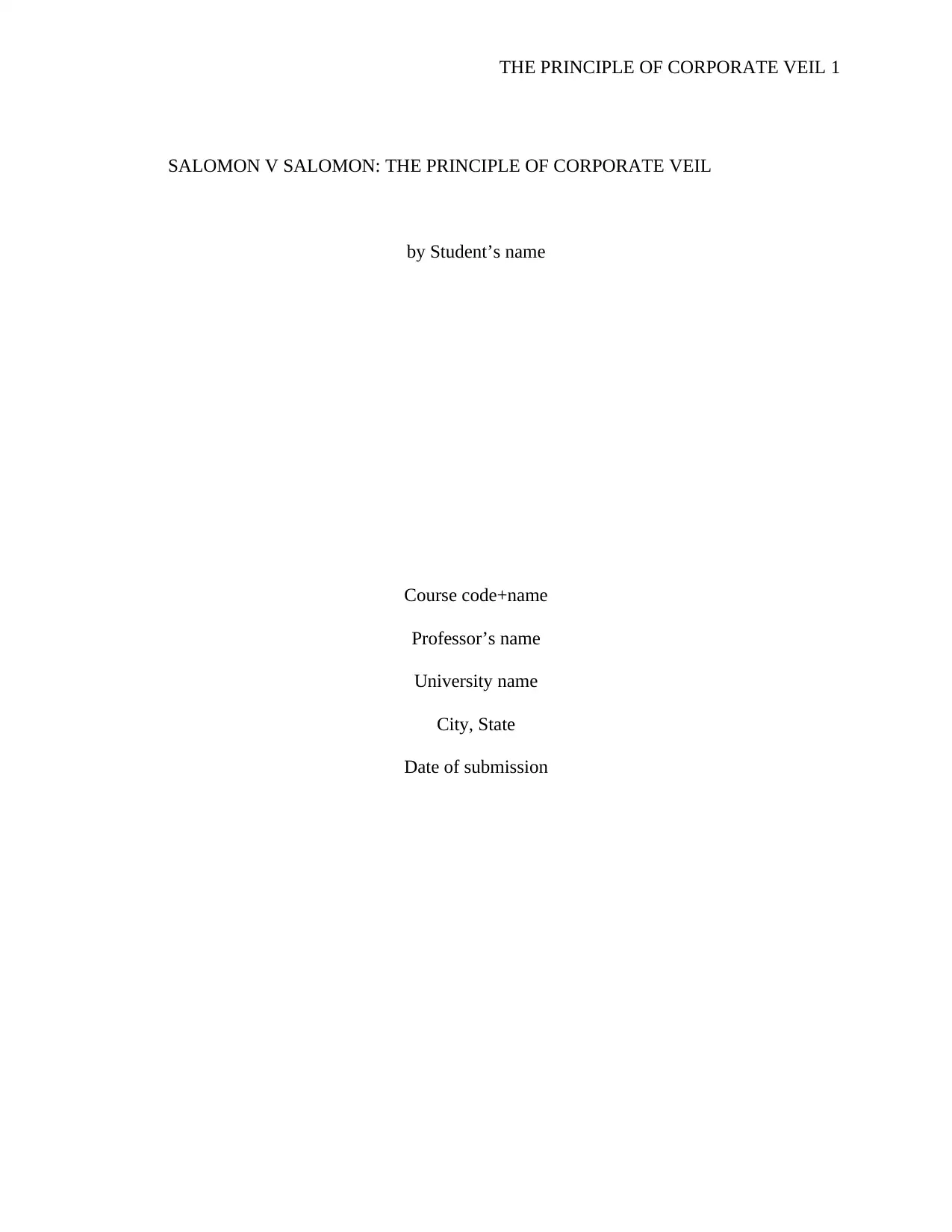
THE PRINCIPLE OF CORPORATE VEIL 1
SALOMON V SALOMON: THE PRINCIPLE OF CORPORATE VEIL
by Student’s name
Course code+name
Professor’s name
University name
City, State
Date of submission
SALOMON V SALOMON: THE PRINCIPLE OF CORPORATE VEIL
by Student’s name
Course code+name
Professor’s name
University name
City, State
Date of submission
Paraphrase This Document
Need a fresh take? Get an instant paraphrase of this document with our AI Paraphraser
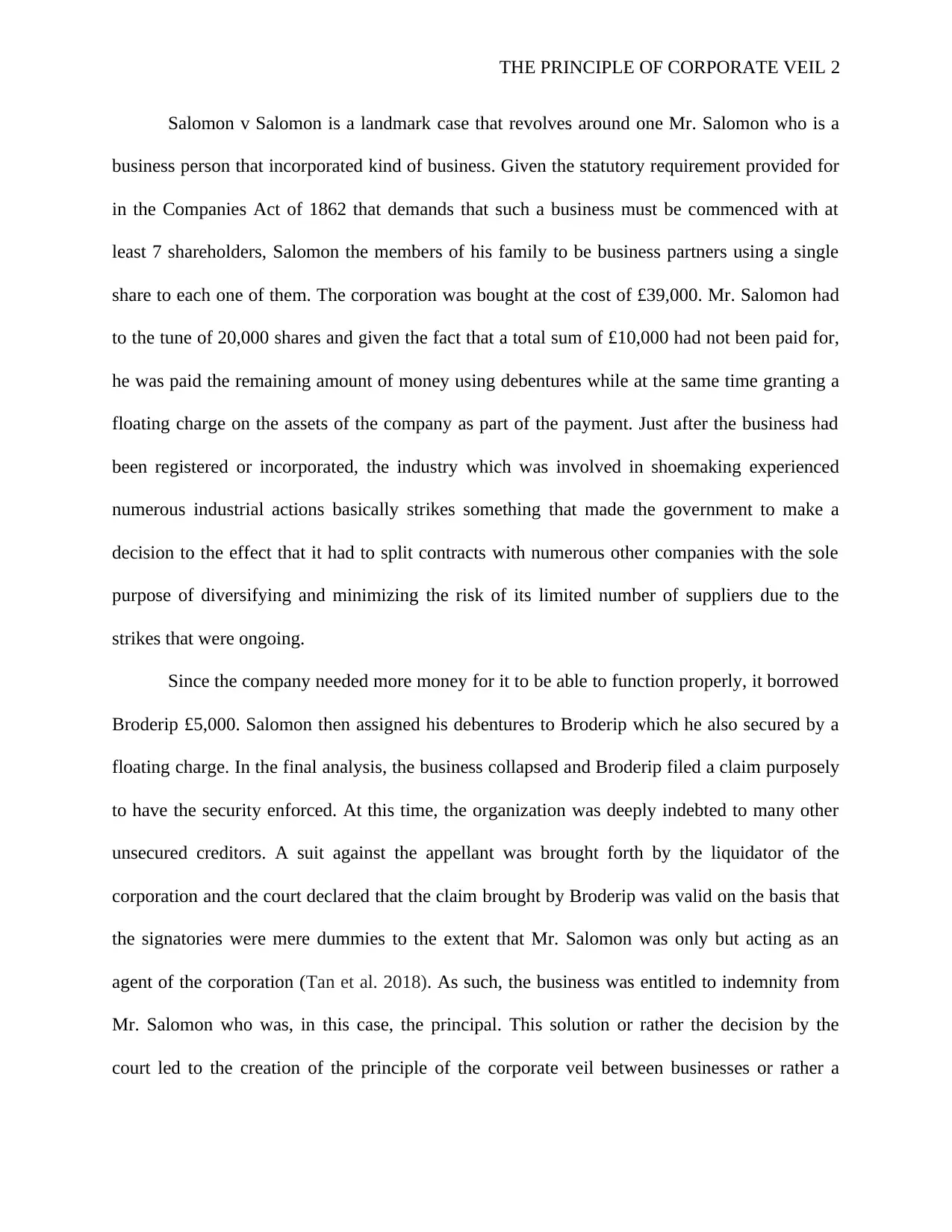
THE PRINCIPLE OF CORPORATE VEIL 2
Salomon v Salomon is a landmark case that revolves around one Mr. Salomon who is a
business person that incorporated kind of business. Given the statutory requirement provided for
in the Companies Act of 1862 that demands that such a business must be commenced with at
least 7 shareholders, Salomon the members of his family to be business partners using a single
share to each one of them. The corporation was bought at the cost of £39,000. Mr. Salomon had
to the tune of 20,000 shares and given the fact that a total sum of £10,000 had not been paid for,
he was paid the remaining amount of money using debentures while at the same time granting a
floating charge on the assets of the company as part of the payment. Just after the business had
been registered or incorporated, the industry which was involved in shoemaking experienced
numerous industrial actions basically strikes something that made the government to make a
decision to the effect that it had to split contracts with numerous other companies with the sole
purpose of diversifying and minimizing the risk of its limited number of suppliers due to the
strikes that were ongoing.
Since the company needed more money for it to be able to function properly, it borrowed
Broderip £5,000. Salomon then assigned his debentures to Broderip which he also secured by a
floating charge. In the final analysis, the business collapsed and Broderip filed a claim purposely
to have the security enforced. At this time, the organization was deeply indebted to many other
unsecured creditors. A suit against the appellant was brought forth by the liquidator of the
corporation and the court declared that the claim brought by Broderip was valid on the basis that
the signatories were mere dummies to the extent that Mr. Salomon was only but acting as an
agent of the corporation (Tan et al. 2018). As such, the business was entitled to indemnity from
Mr. Salomon who was, in this case, the principal. This solution or rather the decision by the
court led to the creation of the principle of the corporate veil between businesses or rather a
Salomon v Salomon is a landmark case that revolves around one Mr. Salomon who is a
business person that incorporated kind of business. Given the statutory requirement provided for
in the Companies Act of 1862 that demands that such a business must be commenced with at
least 7 shareholders, Salomon the members of his family to be business partners using a single
share to each one of them. The corporation was bought at the cost of £39,000. Mr. Salomon had
to the tune of 20,000 shares and given the fact that a total sum of £10,000 had not been paid for,
he was paid the remaining amount of money using debentures while at the same time granting a
floating charge on the assets of the company as part of the payment. Just after the business had
been registered or incorporated, the industry which was involved in shoemaking experienced
numerous industrial actions basically strikes something that made the government to make a
decision to the effect that it had to split contracts with numerous other companies with the sole
purpose of diversifying and minimizing the risk of its limited number of suppliers due to the
strikes that were ongoing.
Since the company needed more money for it to be able to function properly, it borrowed
Broderip £5,000. Salomon then assigned his debentures to Broderip which he also secured by a
floating charge. In the final analysis, the business collapsed and Broderip filed a claim purposely
to have the security enforced. At this time, the organization was deeply indebted to many other
unsecured creditors. A suit against the appellant was brought forth by the liquidator of the
corporation and the court declared that the claim brought by Broderip was valid on the basis that
the signatories were mere dummies to the extent that Mr. Salomon was only but acting as an
agent of the corporation (Tan et al. 2018). As such, the business was entitled to indemnity from
Mr. Salomon who was, in this case, the principal. This solution or rather the decision by the
court led to the creation of the principle of the corporate veil between businesses or rather a
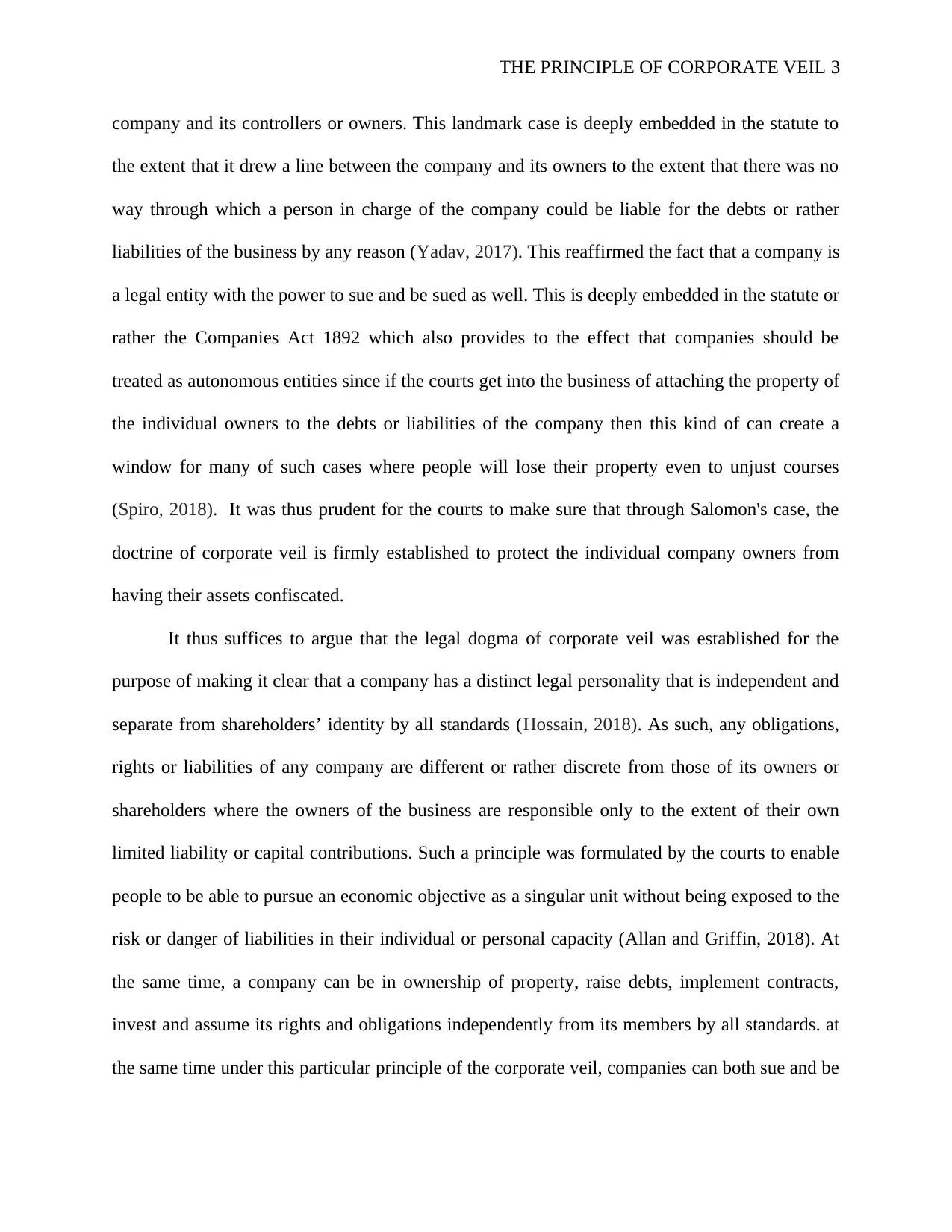
THE PRINCIPLE OF CORPORATE VEIL 3
company and its controllers or owners. This landmark case is deeply embedded in the statute to
the extent that it drew a line between the company and its owners to the extent that there was no
way through which a person in charge of the company could be liable for the debts or rather
liabilities of the business by any reason (Yadav, 2017). This reaffirmed the fact that a company is
a legal entity with the power to sue and be sued as well. This is deeply embedded in the statute or
rather the Companies Act 1892 which also provides to the effect that companies should be
treated as autonomous entities since if the courts get into the business of attaching the property of
the individual owners to the debts or liabilities of the company then this kind of can create a
window for many of such cases where people will lose their property even to unjust courses
(Spiro, 2018). It was thus prudent for the courts to make sure that through Salomon's case, the
doctrine of corporate veil is firmly established to protect the individual company owners from
having their assets confiscated.
It thus suffices to argue that the legal dogma of corporate veil was established for the
purpose of making it clear that a company has a distinct legal personality that is independent and
separate from shareholders’ identity by all standards (Hossain, 2018). As such, any obligations,
rights or liabilities of any company are different or rather discrete from those of its owners or
shareholders where the owners of the business are responsible only to the extent of their own
limited liability or capital contributions. Such a principle was formulated by the courts to enable
people to be able to pursue an economic objective as a singular unit without being exposed to the
risk or danger of liabilities in their individual or personal capacity (Allan and Griffin, 2018). At
the same time, a company can be in ownership of property, raise debts, implement contracts,
invest and assume its rights and obligations independently from its members by all standards. at
the same time under this particular principle of the corporate veil, companies can both sue and be
company and its controllers or owners. This landmark case is deeply embedded in the statute to
the extent that it drew a line between the company and its owners to the extent that there was no
way through which a person in charge of the company could be liable for the debts or rather
liabilities of the business by any reason (Yadav, 2017). This reaffirmed the fact that a company is
a legal entity with the power to sue and be sued as well. This is deeply embedded in the statute or
rather the Companies Act 1892 which also provides to the effect that companies should be
treated as autonomous entities since if the courts get into the business of attaching the property of
the individual owners to the debts or liabilities of the company then this kind of can create a
window for many of such cases where people will lose their property even to unjust courses
(Spiro, 2018). It was thus prudent for the courts to make sure that through Salomon's case, the
doctrine of corporate veil is firmly established to protect the individual company owners from
having their assets confiscated.
It thus suffices to argue that the legal dogma of corporate veil was established for the
purpose of making it clear that a company has a distinct legal personality that is independent and
separate from shareholders’ identity by all standards (Hossain, 2018). As such, any obligations,
rights or liabilities of any company are different or rather discrete from those of its owners or
shareholders where the owners of the business are responsible only to the extent of their own
limited liability or capital contributions. Such a principle was formulated by the courts to enable
people to be able to pursue an economic objective as a singular unit without being exposed to the
risk or danger of liabilities in their individual or personal capacity (Allan and Griffin, 2018). At
the same time, a company can be in ownership of property, raise debts, implement contracts,
invest and assume its rights and obligations independently from its members by all standards. at
the same time under this particular principle of the corporate veil, companies can both sue and be
⊘ This is a preview!⊘
Do you want full access?
Subscribe today to unlock all pages.

Trusted by 1+ million students worldwide
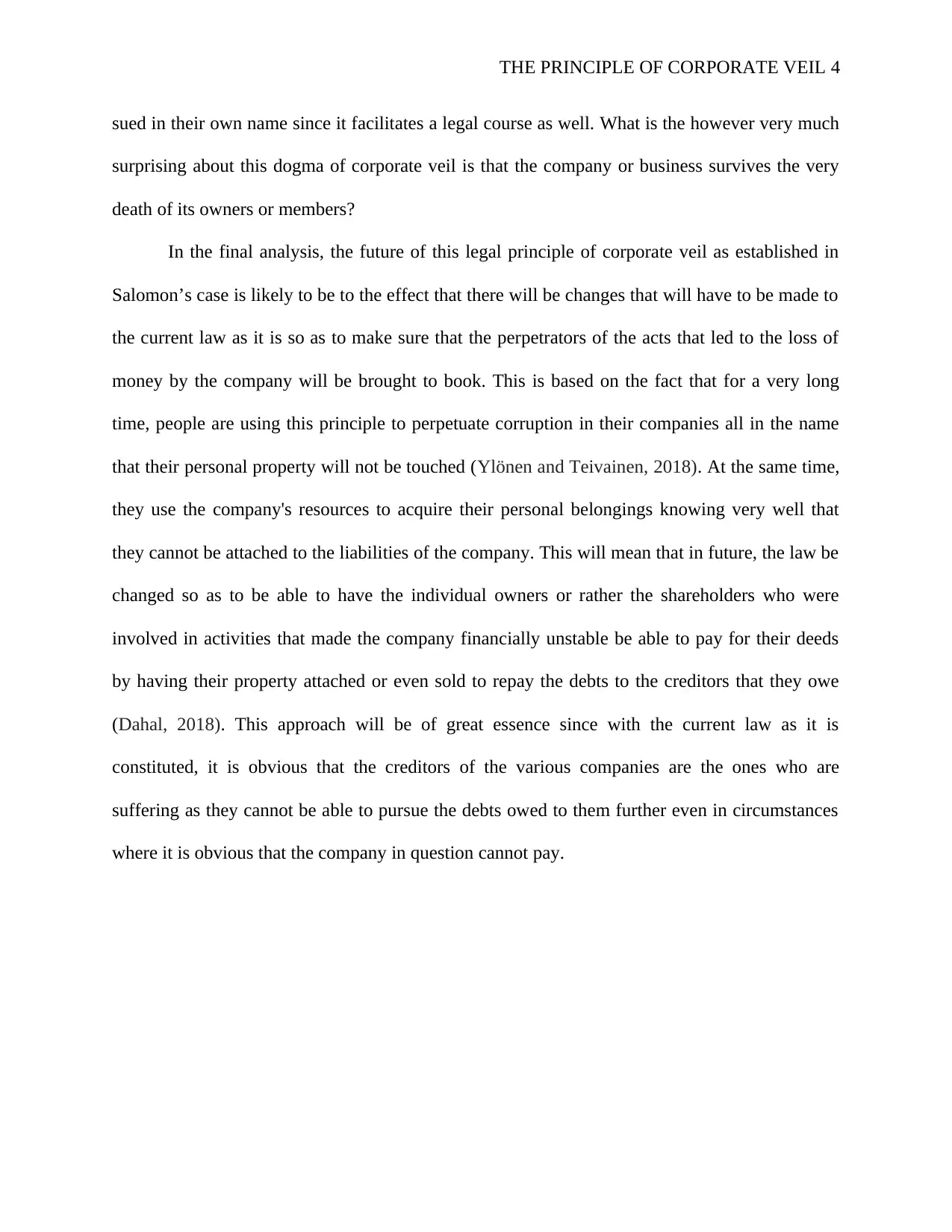
THE PRINCIPLE OF CORPORATE VEIL 4
sued in their own name since it facilitates a legal course as well. What is the however very much
surprising about this dogma of corporate veil is that the company or business survives the very
death of its owners or members?
In the final analysis, the future of this legal principle of corporate veil as established in
Salomon’s case is likely to be to the effect that there will be changes that will have to be made to
the current law as it is so as to make sure that the perpetrators of the acts that led to the loss of
money by the company will be brought to book. This is based on the fact that for a very long
time, people are using this principle to perpetuate corruption in their companies all in the name
that their personal property will not be touched (Ylönen and Teivainen, 2018). At the same time,
they use the company's resources to acquire their personal belongings knowing very well that
they cannot be attached to the liabilities of the company. This will mean that in future, the law be
changed so as to be able to have the individual owners or rather the shareholders who were
involved in activities that made the company financially unstable be able to pay for their deeds
by having their property attached or even sold to repay the debts to the creditors that they owe
(Dahal, 2018). This approach will be of great essence since with the current law as it is
constituted, it is obvious that the creditors of the various companies are the ones who are
suffering as they cannot be able to pursue the debts owed to them further even in circumstances
where it is obvious that the company in question cannot pay.
sued in their own name since it facilitates a legal course as well. What is the however very much
surprising about this dogma of corporate veil is that the company or business survives the very
death of its owners or members?
In the final analysis, the future of this legal principle of corporate veil as established in
Salomon’s case is likely to be to the effect that there will be changes that will have to be made to
the current law as it is so as to make sure that the perpetrators of the acts that led to the loss of
money by the company will be brought to book. This is based on the fact that for a very long
time, people are using this principle to perpetuate corruption in their companies all in the name
that their personal property will not be touched (Ylönen and Teivainen, 2018). At the same time,
they use the company's resources to acquire their personal belongings knowing very well that
they cannot be attached to the liabilities of the company. This will mean that in future, the law be
changed so as to be able to have the individual owners or rather the shareholders who were
involved in activities that made the company financially unstable be able to pay for their deeds
by having their property attached or even sold to repay the debts to the creditors that they owe
(Dahal, 2018). This approach will be of great essence since with the current law as it is
constituted, it is obvious that the creditors of the various companies are the ones who are
suffering as they cannot be able to pursue the debts owed to them further even in circumstances
where it is obvious that the company in question cannot pay.
Paraphrase This Document
Need a fresh take? Get an instant paraphrase of this document with our AI Paraphraser
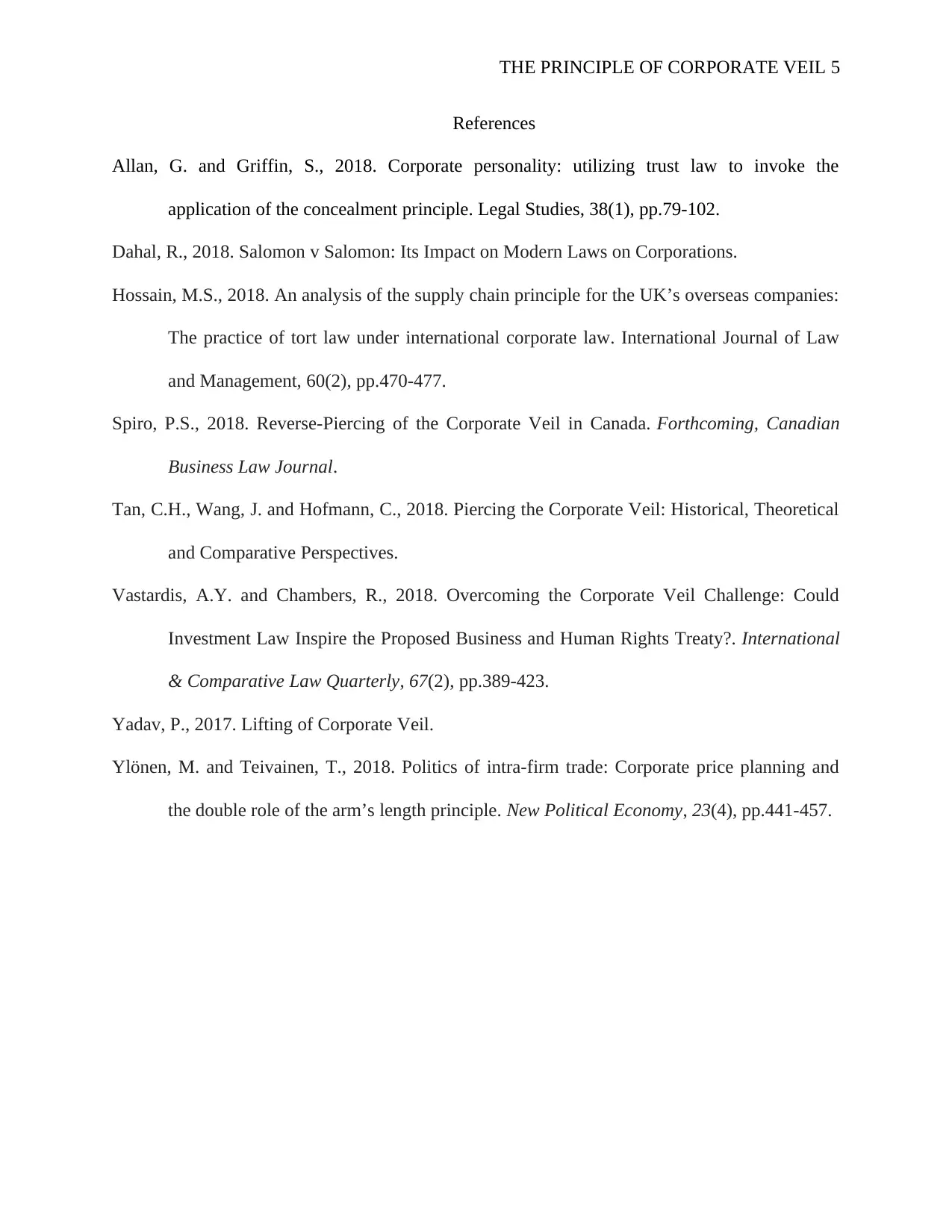
THE PRINCIPLE OF CORPORATE VEIL 5
References
Allan, G. and Griffin, S., 2018. Corporate personality: utilizing trust law to invoke the
application of the concealment principle. Legal Studies, 38(1), pp.79-102.
Dahal, R., 2018. Salomon v Salomon: Its Impact on Modern Laws on Corporations.
Hossain, M.S., 2018. An analysis of the supply chain principle for the UK’s overseas companies:
The practice of tort law under international corporate law. International Journal of Law
and Management, 60(2), pp.470-477.
Spiro, P.S., 2018. Reverse-Piercing of the Corporate Veil in Canada. Forthcoming, Canadian
Business Law Journal.
Tan, C.H., Wang, J. and Hofmann, C., 2018. Piercing the Corporate Veil: Historical, Theoretical
and Comparative Perspectives.
Vastardis, A.Y. and Chambers, R., 2018. Overcoming the Corporate Veil Challenge: Could
Investment Law Inspire the Proposed Business and Human Rights Treaty?. International
& Comparative Law Quarterly, 67(2), pp.389-423.
Yadav, P., 2017. Lifting of Corporate Veil.
Ylönen, M. and Teivainen, T., 2018. Politics of intra-firm trade: Corporate price planning and
the double role of the arm’s length principle. New Political Economy, 23(4), pp.441-457.
References
Allan, G. and Griffin, S., 2018. Corporate personality: utilizing trust law to invoke the
application of the concealment principle. Legal Studies, 38(1), pp.79-102.
Dahal, R., 2018. Salomon v Salomon: Its Impact on Modern Laws on Corporations.
Hossain, M.S., 2018. An analysis of the supply chain principle for the UK’s overseas companies:
The practice of tort law under international corporate law. International Journal of Law
and Management, 60(2), pp.470-477.
Spiro, P.S., 2018. Reverse-Piercing of the Corporate Veil in Canada. Forthcoming, Canadian
Business Law Journal.
Tan, C.H., Wang, J. and Hofmann, C., 2018. Piercing the Corporate Veil: Historical, Theoretical
and Comparative Perspectives.
Vastardis, A.Y. and Chambers, R., 2018. Overcoming the Corporate Veil Challenge: Could
Investment Law Inspire the Proposed Business and Human Rights Treaty?. International
& Comparative Law Quarterly, 67(2), pp.389-423.
Yadav, P., 2017. Lifting of Corporate Veil.
Ylönen, M. and Teivainen, T., 2018. Politics of intra-firm trade: Corporate price planning and
the double role of the arm’s length principle. New Political Economy, 23(4), pp.441-457.

THE PRINCIPLE OF CORPORATE VEIL 6
⊘ This is a preview!⊘
Do you want full access?
Subscribe today to unlock all pages.

Trusted by 1+ million students worldwide
1 out of 6
Related Documents
Your All-in-One AI-Powered Toolkit for Academic Success.
+13062052269
info@desklib.com
Available 24*7 on WhatsApp / Email
![[object Object]](/_next/static/media/star-bottom.7253800d.svg)
Unlock your academic potential
Copyright © 2020–2025 A2Z Services. All Rights Reserved. Developed and managed by ZUCOL.





